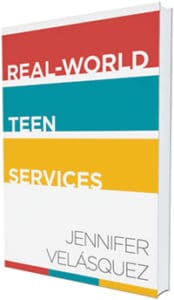
Cultivating a space in the library that teens can activate and own sends teens a strong signal they are valued and welcome. In the book Real-World Teen Services (ALA Editions, 2015), Jennifer Velásquez stresses the need for a dedicated teen space and how library staffers can best serve their teens.
Velásquez is a lecturer at San José State University School of Information and coordinator of teen services for San Antonio Public Library. She is the recipient of the 2005 New York Times Librarian Award and holds a master’s degree from Rutgers University School of Communication and Information. An excerpt from her book was published in the September/October issue of American Libraries.
What made you want to write this book?
A few years ago, I did a presentation at an ALA Annual Conference about teens’ mobile technology usage patterns and their implications for libraries. It was specific and—I believed—thought-provoking stuff. When the allotted question-and-answer segment arrived, librarians from around the country instead asked questions about basic teen library services and situations. It wasn’t the first time that the topic at hand was pushed aside by a hunger to talk about “the basics.” A quick look at the available titles on teen library services finds few, if any, that deal with these basics—so I wrote the book I wished I’d had as a library science student or as a new teen librarian just beginning my career. The response has been overwhelmingly positive, from students in my course at San Jose State who use it as a springboard for real-world discussions to librarians working as generalists wishing to brush up on teen services skills.
Why would ALA members find it helpful?

Teen librarians often function as lone wolves in their organization, and the book serves as a guide to helping them in this unique and often stressful service landscape. It covers the basics on planning teen spaces, stressing experiences over features; offers a programming framework that focuses on experiences, not activities; tackles the nitty-gritty of unwanted behavior by both staff and teens; and addresses topics like truancy and the subtle but insidious inequities in service to teens. Managers will also find helpful its overview of the vital role they play in the success of teen services in the library.
What is the most surprising thing you discovered while working on this book?
While writing the book I had the opportunity to speak with many passionate teen librarians from around the world. I think the most surprising thing I discovered was the universality of their experiences. Whether librarians are in New Zealand, Brazil, or Denmark, they all face the same challenges, celebrate the same successes, and strive for the same goals. But what most strongly unites teen librarians is the level of internal advocacy they must undertake. Teen librarians are fierce advocates, and they have to be because they are often called upon to justify even the most basic teen services in a way that other age-based specialists are not required to do. The stresses and rewards of this seem universal, too.
What are you reading right now?
I’m reading Making Is Connecting: The Social Meaning of Creativity, from DIY and Knitting to YouTube and Web 2.0, by David Gauntlett. I return to this book again and again, because it helps me refocus on the “why” of the so-called DIY movement in the library. There is just so much goofiness and mission creep when it comes to the notion of “making.” I think we need to get over ourselves and recognize that the library has been making things with teens for decades. The materials and technology may have changed but the results and goals are the same. Making truly is about connecting. If you are a teen librarian, you should read it.
What is your next project?
I’m working on a preconference for the YALSA Symposium in November. I’ll present along with Jason Yip from the University of Washington iSchool and Juan Rubio of Seattle Public Library. Our session is called “The Participatory Library: Partnering with Teens to Design Library Learning Experiences.” We will offer tools and strategies for involving teens in a full spectrum of codesign opportunities that will be useful for the development of everything from basic teen library events to the prototyping of new library services and products. It’s exciting to have the chance to work with and learn from colleagues who are truly doing groundbreaking work. Hopefully a publication will come out of this collaboration—something to better clarify the charge forward and help librarians get to “why.”


